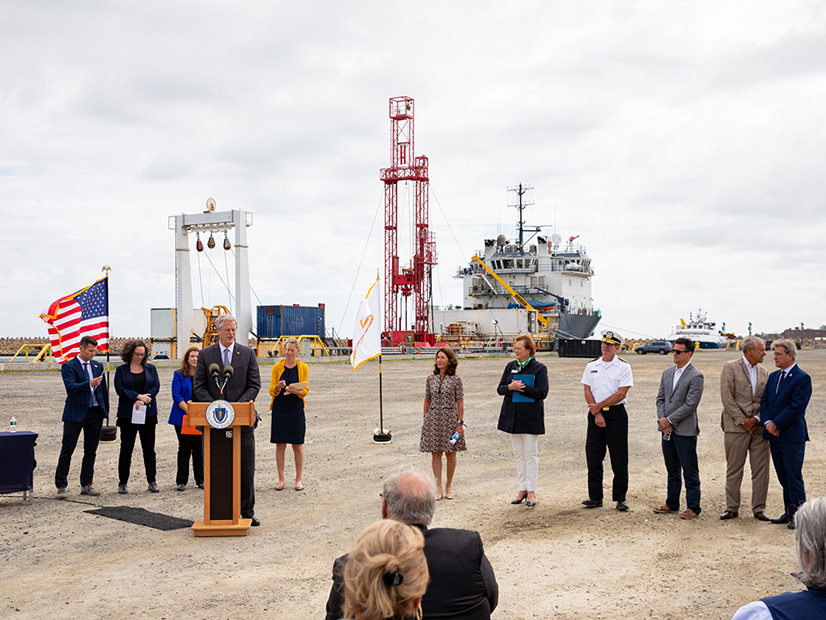
More than half of the jobs needed to build Massachusetts’ first 1.6 GW of offshore wind (OSW) have a moderate to significant workforce gap in the state, according to a report released Wednesday.
The 2021 MassCEC Offshore Wind Workforce Assessment found a significant workforce gap for 36% of the occupations needed to develop the state’s OSW. An additional 27% have a moderate workforce gap, and 37% have sufficient workers.
Gov. Charlie Baker joined state and local officials at the New Bedford Marine Commerce Terminal to announce the release of the report, which BW Research Partnership prepared for the Massachusetts Clean Energy Center.
“As Massachusetts prepares for the construction of the first commercial-scale offshore wind project in the nation, our administration is focused on ensuring our workforce is trained, ready and offers pathways to employment for all residents, especially in the communities that can most benefit from this generational economic opportunity,” Baker said.
Massachusetts is most prepared to supply management and engineering professionals and maritime workers, but it lacks construction laborers, transportation workers and general maintenance workers, the report said.
Training
To help the state fill existing workforce gaps, the report identified relevant training options for individuals who are employed and need training or are already in an educational program, and people not currently employed.
Massachusetts has an opportunity to close the workforce gap in construction and operations by ensuring that people who already have jobs can access OWS safety training.
“Developers consistently identified [Global Wind Organization basic safety training] of a sufficient number of workers as the number one workforce development priority,” the report said.
In addition, the state could support organizations interested in participating in the OSW supply chain by connecting them with and funding certificate training, such as OSHA and Lean Six Sigma.
Current maritime workers also can fill specific workforce needs if they receive specialized training, but the report said recruiting in that sector will be a challenge. Members of the fishing industry, for example, can be adversarial, and navigation near project infrastructure requires more precision than other maritime work.
Those issues, however, are not insurmountable, the report said. The state can improve messaging around the economic opportunities for maritime workers and continue funding professional programs, such as the Fishing Partnership Support Services and Gloucester Fishermen’s Wives Development Program. Additional investment from the state in virtual reality technologies also will help the industry ensure OSW supply organizations can provide technical training for their products.
Education
Massachusetts has relevant vocational and higher education infrastructure that would allow the OSW industry to communicate job opportunities and connect with potential workers.
Filling construction and trade workforce gaps could be accomplished through early engagement in vocational-technical high schools in the state, according to the report.
“OSW stakeholders expressed that early exposure to the industry is key in physically and mentally preparing workers to endure water conditions,” the report said.
Existing higher education programs in the state also will support professionals interested in transitioning their skill sets to OSW.
“Initiatives like the development of a graduate certificate at [University of Massachusetts] (UMass) Amherst and OSW curricular and extracurricular development at UMass Lowell should continue to be supported and advertised,” the report said.
A partnership of Massachusetts academic institutions, called POWER US-MA, would benefit from state support to further its existing collaborations. The group lacks the resources for expansion, the report said, adding that its active research network and vision to expand “provides a valuable opportunity to the workforce development space.”
Equity
Removing barriers to entering the OSW workforce for people who have been unemployed long term will help the state create equitable job opportunities. People out of work for the longest in the state, according to the report, are primarily ethnic and racial minorities in lower-income households and communities.
A review based on state census tracts identified 28 towns that would benefit from focused workforce training and development opportunities. These “priority communities” meet key indicators for economic, demographic, social and housing criteria. All the towns meet the state’s definition of an environmental justice population, which includes an annual median household income that is no more than 65% of the statewide median household income.
Many potential workers in the priority communities “suffer from the trauma of poverty and may experience food insecurity, housing insecurity, transportation insecurity or substance abuse,” the report said. A pre-training program would help the individuals overcome those barriers to workforce entry.
State investments in priority communities could include transportation and housing support and pre-apprenticeship programs that recruit women, veterans and minorities.
Collaboration
The Massachusetts OSW sector does not exist in a bubble, and the state’s efforts to build a workforce to support the sector should acknowledge the programs and initiatives of other states in the region.
Through collaboration in the Northeast, the report said, the states will avoid duplicating their training efforts.
Developers want to secure a trusted workforce that can be used in projects throughout the region, the report said.
Some OSW occupations may be competitive geographically. Massachusetts, for example, could provide maritime workers, engineers, marine scientists, and industry professionals for projects in other states, according to the report. But to benefit from those synergies, the Northeast should create a centralized organization for OSW workforce development strategies, the report said.

